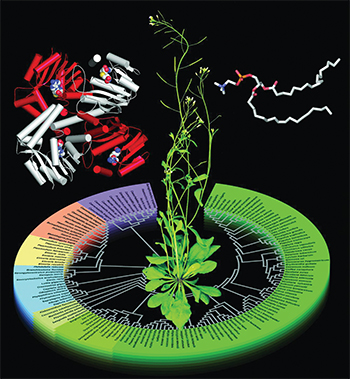JBC: A phospholipid pathway from plants to parasites
Findings by researchers at may aid in the development of therapies to treat parasitic infections, including malaria, and may help plant scientists one day produce hardier crops. The research team’s in the Journal of Biological Chemistry.
 A study explains how structures of Arabidopsis phosphoethanolamine methyltransferase, or PMT, (left) are evolutionarily related to PMT sequences from different organisms. Phosphatidylcholine (right) is PMT's product. Courtesy of Soon Goo Lee and Joseph JezCholine is an essential nutrient that we get from certain foods, including eggs, meat, leafy greens and nuts. The human body converts choline into phosphocholine, or pCho, which it in turn converts into (among other essential building blocks) phosphatidylcholine, or PtdCho, a component of cell membranes. Plants can’t acquire the nutrient from the environment and so must synthesize pCho from scratch. The biochemical pathway plants use to synthesize pCho also is found in nematodes and the malaria parasite Plasmodium.
A study explains how structures of Arabidopsis phosphoethanolamine methyltransferase, or PMT, (left) are evolutionarily related to PMT sequences from different organisms. Phosphatidylcholine (right) is PMT's product. Courtesy of Soon Goo Lee and Joseph JezCholine is an essential nutrient that we get from certain foods, including eggs, meat, leafy greens and nuts. The human body converts choline into phosphocholine, or pCho, which it in turn converts into (among other essential building blocks) phosphatidylcholine, or PtdCho, a component of cell membranes. Plants can’t acquire the nutrient from the environment and so must synthesize pCho from scratch. The biochemical pathway plants use to synthesize pCho also is found in nematodes and the malaria parasite Plasmodium.
In plants, the enzymatic reaction that produces pCho is essential for normal function and for responding to stresses. Plant pCho is converted into PtdCho, which builds membranes that can adjust their rigidity in response to temperature changes. pCho also gets converted into molecules that help plants survive high salt. The enzymes that produce plant pCho are called phosphoethanolamine methyltransferases, or PMTs.
, a postdoctoral research fellow at Washington University in the lab of (a JBC associate editor), has been fascinated by PMTs in both plants and parasites for many years.
“Understanding the PMT enzyme is key to engineer plants with improved stress tolerance and enhanced nutrients,” Lee said.
Since the PMT-catalyzed pathway is found in parasites but not humans, Lee and Jez’s team is looking for inhibitors of this enzyme to treat diseases caused by these parasites.
The new study explains that PMTs of the model plant Arabidopsis thaliana share core features of PMTs from parasites, with almost identical structure at the active site. But the plant PMTs are roughly twice as large as the parasite ones, with large sections that can rearrange themselves to carry out multiple chemical reactions.
The three PMT types in the plant — which were thought to carry out the same function — actually appear to play different roles depending on where they are found in the plant. Plant growth experiments showed that one type of PMT was essential for root development and salt tolerance, whereas the other two had no effect on roots and instead seemed to be found primarily in leaves.
In the long run, this big-picture view of PMTs in different organisms offers routes to engineer enzymes with different functions. “I love these kinds of stories,” Lee said, “where I can look from the atomic (structure) to the physiological level to explain why these enzymes have different forms and how they work.”
Enjoy reading ASBMB Today?
Become a member to receive the print edition four times a year and the digital edition weekly.
Learn moreGet the latest from ASBMB Today
Enter your email address, and we’ll send you a weekly email with recent articles, interviews and more.
Latest in Science
Science highlights or most popular articles

Elucidating how chemotherapy induces neurotoxicity
Andre Nussenzweig will receive the Bert and Natalie Vallee Award at the 2025 ASBMB Annual Meeting, April 12–15 in Chicago.

Where do we search for the fundamental stuff of life?
Recent books by Thomas Cech and Sara Imari Walker offer two perspectives on where to look for the basic properties that define living things.

UCLA researchers engineer experimental drug for preventing heart failure after heart attacks
This new single-dose therapy blocks a protein that increases inflammation and shows promise in enhancing muscle repair in preclinical models.

The decision to eat may come down to these three neurons
The circuit that connects a hunger-signaling hormone to the jaw to stimulate chewing movements is surprisingly simple, Rockefeller University researchers have found.

Curiosity turned a dietitian into a lipid scientist
Judy Storch will receive the Avanti Award in Lipids at the 2025 ASBMB Annual Meeting, April 12–15 in Chicago.

From receptor research to cancer drug development: The impact of RTKs
Joseph Schlessinger will receive the ASBMB Herbert Tabor Research Award at the 2025 ASBMB Annual meeting, April 12–15 in Chicago.

.jpg?lang=en-US&width=300&height=300&ext=.jpg)